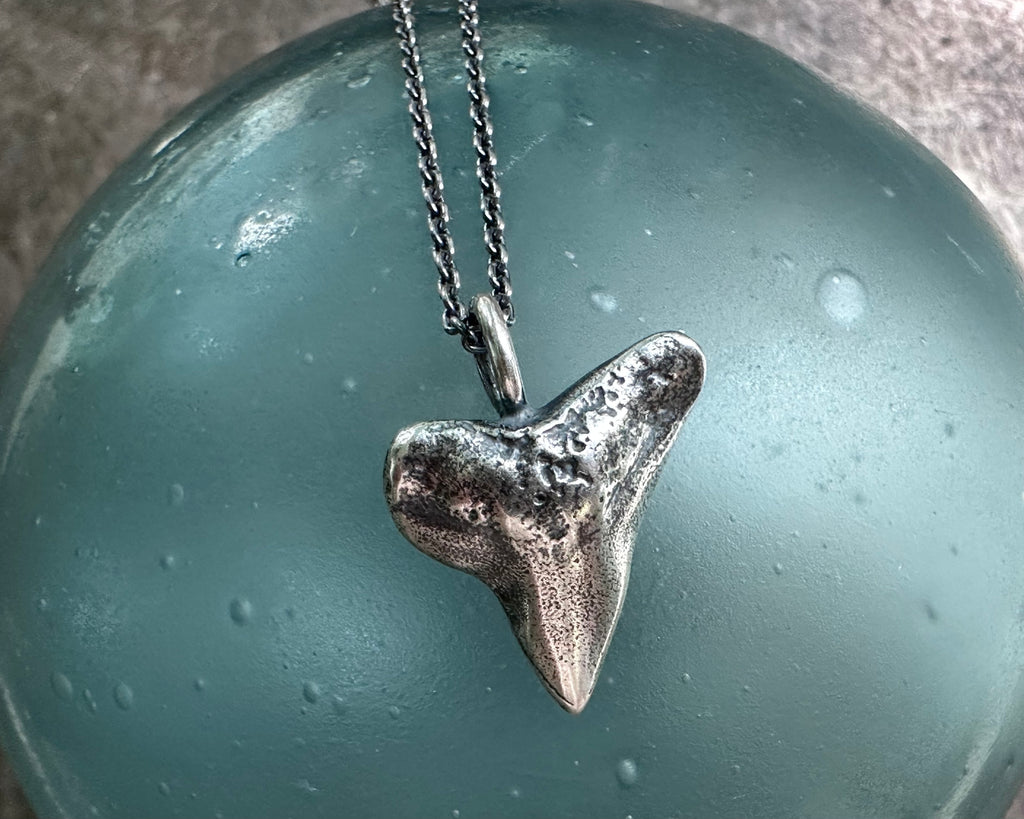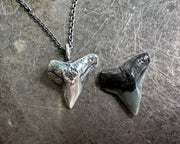shark tooth talisman necklace pendant
A sterling silver shark tooth talisman necklace pendant ... endlessly interesting jewelry with a few nods to history.
Its symbolism varies by culture and era but generally speaking a shark tooth pendant is a talisman meant to protect and bring good fortune.
- approximate measurement - 3/4” (20mm) including loop x 5/8“ (17mm)
- the shark tooth charm is solid, not hollow and 3D, beautifully textured all around
- metal - sterling silver (.925 silver
)
*** shark tooth charm only - the chain is sold separately here
- photographed with a US dime and inch ruler for scale
I sand cast this shark tooth from a fossilized shark tooth I found in Venice, FL, likely from a bull shark ... Florida was submerged underwater 10 million years ago and the area was teeming with sharks but as the water receded giving way to land, the prehistoric sharks died - their skeletons disintegrated but their fossilized teeth remained.
After sand casting and cleaning up I had it lost wax cast in sterling silver ... hand crafted jewelry when how it's made matters.
Shark teeth have long been amulets believed to be endowed with special powers to protect or to bring good fortune. The legends are many about the powers of wearing a fossilized shark tooth necklace and here are just a few …
In Hawaiian legend wearing a shark tooth necklace was a symbol of strength and protection, both protection at sea and protection from sharks.
During the Renaissance, fossilized shark teeth were useful in detecting poison in food or drink at royal banquets, since a favorite way to dispatch the enemy was to poison their food or drink with arsenic or similar which was tasteless … the shark tooth root, encased in silver and fitted with a loop, as a pendant or an item of tableware (on elaborate tree-like structures called Natternzungen-credenz) keeps one safer from poison because it sweats and changes color when poison is present. For example, it would be dipped in wine before it was drunk and if there was no color change when lifted from the goblet the wine was safe to drink.
By the Victorian era, nature imitating nature in jewelry (parts of animals, birds, insects, shells, fish, coral, teeth, claws) was not really new but the way in which these ornaments were accepted as fashion accessories was new. The Great Exhibition, in 1851, at the Crystal Palace enhanced this by making available this nature from around the world and for many, their knowledge of these exotic species was derived purely from their use in jewelry and accessories.
“My life is like a stroll on the beach... as near to the edge as I can go”
~ Henry David Thoreau













 Pin it
Pin it